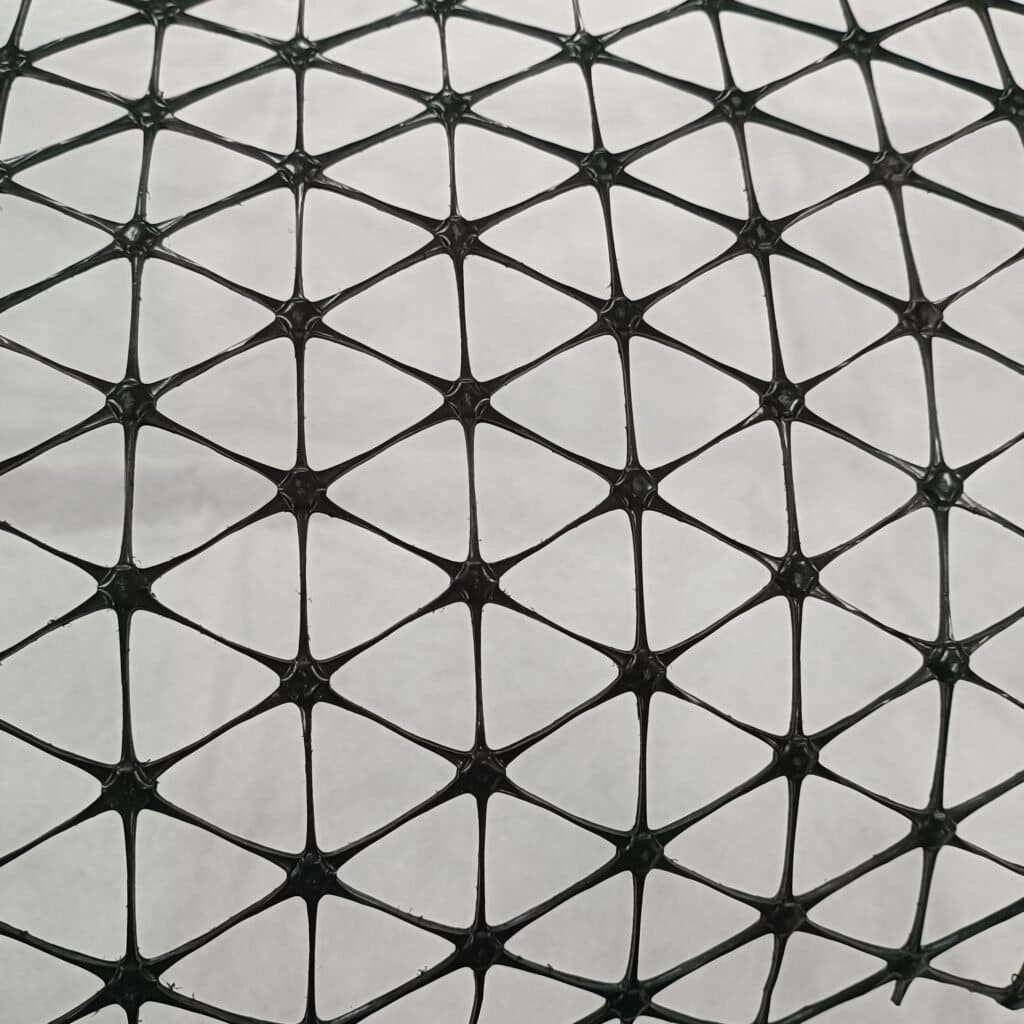Triaxial geogrid manufacturers· How to improve foundation stability, enhance soil bearing capacity and extend the life of the project has become an important topic in engineering design and construction. As a new type of geosynthetics, triaxial geogrid is increasingly used in civil engineering due to its three-dimensional structure and significant soil reinforcement effect. Triaxial geogrid has not only been widely used in traditional infrastructure construction such as roads and railways, but also has shown its unique advantages in many emerging fields.
The definition, characteristics and applications of triaxial geogrid, analyze its role and effect in different engineering fields, and further explain how this material can improve soil strength, stability and durability through innovative structural design.
What is triaxial geogrid?
Triaxial geogrid is a three-dimensional grid structure made of high-strength polymer materials (such as polypropylene (PP), polyester (PET), etc.) through a special stretching process. This material is different from traditional unidirectional geogrids and bidirectional geogrids. It is characterized by a three-dimensional structure in the longitudinal, transverse and diagonal directions, thus forming a geotechnical reinforcement material with excellent stability.
Materials for three-dimensional geogrids
The materials for three-dimensional geogrids are generally polymers with high tensile strength, corrosion resistance and UV resistance.
Polypropylene (PP): has good chemical stability and UV resistance, and is widely used in general engineering construction.
Polyester (PET): has high tensile strength and durability, and is suitable for civil engineering with high load-bearing capacity.
Features of triaxial geogrid manufacturers
- Triaxial geogrid structure; the three-dimensional structure of three-dimensional geogrids can provide enhanced tensile strength and stability in multiple directions. This structure can not only effectively disperse the load, but also enhance the bonding force with the surrounding soil, thereby effectively improving the bearing capacity of the soil.
- High tensile strength; the three-dimensional geogrid is made of high-strength polymer materials, has excellent tensile strength, and can withstand large loads. It can share the load of the foundation in projects such as roads, railways, and dams, and reduce the settlement and deformation of the soil.
- Compression resistance and deformation resistance; the structural design of the three-dimensional geogrid enables it to effectively prevent soil deformation, especially in soft soil or unstable soil conditions, and can effectively stabilize the soil to prevent collapse or settlement.
- Strong durability; using UV-resistant and corrosion-resistant materials, the three-dimensional geogrid can still be used for a long time in harsh environments, has a long service life, and can maintain its performance under environmental conditions such as high humidity and high temperature.
- Easy construction: The lightweight design and high flexibility of the three-dimensional geogrid make it very convenient to transport and construct, and the construction speed is fast, which can significantly reduce the construction period of the project.
- Environmental protection: triaxial geogrid manufacturers is made of environmentally friendly materials, meets the requirements of green buildings, and can reduce pollution to the natural environment during construction.
Application fields of triaxial geogrid manufacturers
- Road construction reinforcement: In road construction, the main function of triaxial geogrid manufacturers products is to reinforce the roadbed, provide higher bearing capacity and stability, and effectively prevent road cracking and deformation caused by uneven foundation settlement.
- Highway construction: In highway construction, triaxial geogrid manufacturers materials can enhance the stability of the roadbed, prevent cracking and settlement, and improve the bearing capacity and service life of the road.
- Urban road reinforcement: Since urban roads often bear large traffic loads, especially in areas with heavy traffic, the application of triaxial geogrids can improve the stability of the road and reduce daily maintenance costs.
- Railway construction: In railway construction, triaxial geogrid manufacturers products are also used to enhance the stability of the roadbed and prevent settlement and uneven deformation of the railway roadbed. Since railway lines usually carry high-intensity vehicle loads, triaxial geogrids can effectively improve the bearing capacity of the railway roadbed and ensure the long-term stability of the railway track.
- Water conservancy projects and dam reinforcement: triaxial geogrid manufacturers products are widely used in water conservancy projects and dam construction. They can not only enhance the stability of the soil, but also effectively prevent the erosion of the soil by water flow, and reduce the settlement deformation in dams and water conservancy projects.
- Dam reinforcement: In water conservancy projects such as dams and retaining walls, triaxial geogrid manufacturers products can enhance the compressive strength of the soil and prevent the deformation and cracks of the dam body caused by water flow.
- Reservoir slope reinforcement: triaxial geogrid manufacturers products can be used to reinforce the slope of the reservoir, prevent soil sliding and collapse, and ensure the safety of the reservoir.
- Landfill: triaxial geogrid manufacturers products are also widely used in the construction of landfill infrastructure. In landfills, three-dimensional geogrids can prevent the settlement of garbage accumulation areas, enhance the stability of landfills, and reduce the impact on the environment.
- Mines and quarries: In soil reinforcement in mines and quarries, triaxial geogrid manufacturers products can enhance the stability of the foundation, prevent mine landslides and quarry slope collapses, and its application helps to improve the safety and efficiency of mining operations.
- Airport runway and infrastructure construction: In large infrastructure projects such as airport runways, three-dimensional geogrids are used to reinforce the roadbed, share the load applied to the road surface, prevent soil settlement and cracks, and ensure the long-term stable operation of the infrastructure.
- Highway slope reinforcement: triaxial geogrid manufacturers products are widely used in highway slope reinforcement to reduce the risk of landslides and collapses, and ensure the long-term stability of the slope by enhancing the tensile strength and stability of the soil.
- Green infrastructure and environmental protection projects: Due to the environmental protection characteristics of triaxial geogrid manufacturers products, three-dimensional geogrids have also been widely used in green infrastructure construction and environmental protection projects. For example, in green buildings, landscape civil engineering, sewage treatment plants and other projects, three-dimensional geogrids can enhance soil stability while reducing environmental impact.






